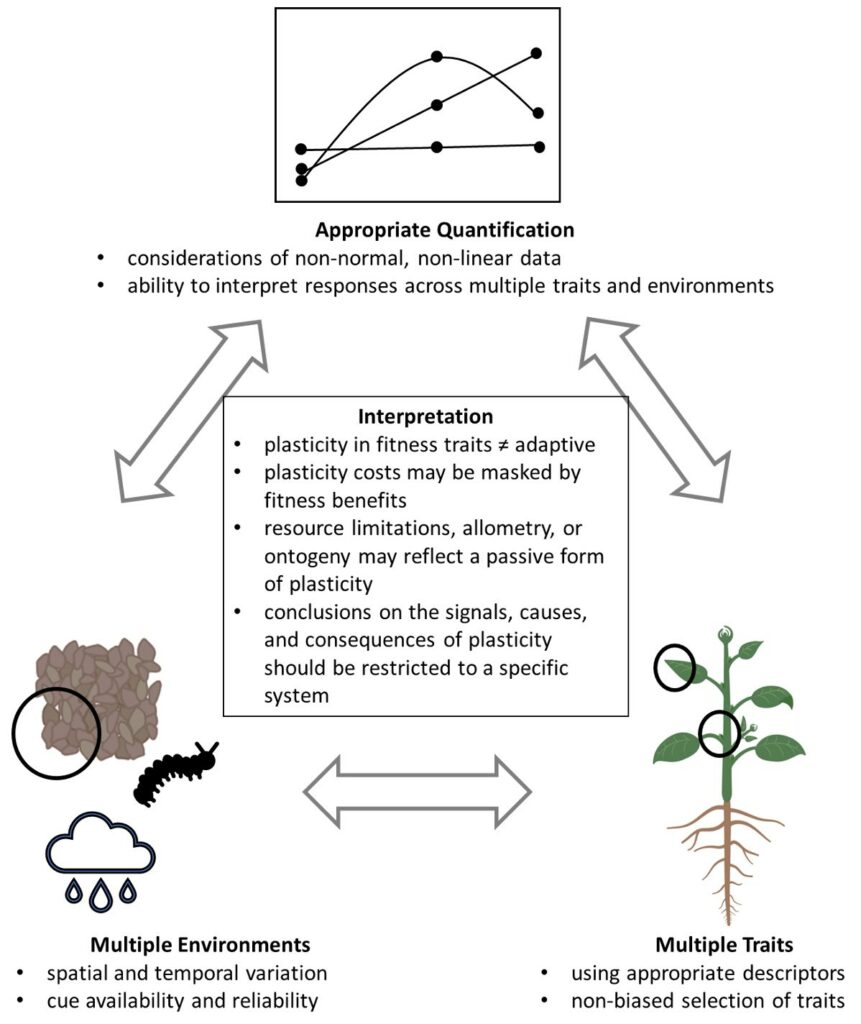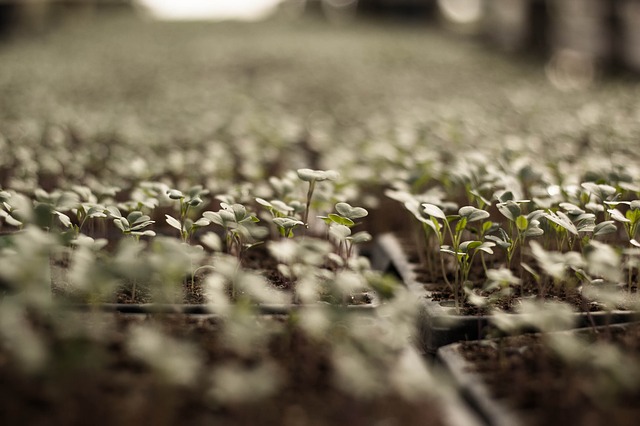Author: Dr Hannah Schneider, researcher based at Wageningen University and Research, Wageningen, Netherlands.
Phenotypic plasticity in plants occurs at all biological scales in every organism. Phenotypic plasticity is defined as the physical and/or metabolic responses of organisms to their environment. Some plastic responses may be strategies that enhance fitness in specific environments. In contrast, other forms of plasticity may be symptoms of stress or pathology, all of which may develop at different time scales. Our recent review (Schneider, 2022) highlights the characterization, costs, cues, and future perspectives of phenotypic plasticity.
Characteristics of Plasticity
There is a wide range of terminology used to describe phenotypic plasticity. The word ‘plasticity’ itself can be deceiving as it does not refer to a single characteristic of living organisms. An organism cannot be entirely plastic. In individual plants, a specific trait may have a plastic response to a specific environment, but a canalized response (i.e. phenotype does not change) to other environments. Plants may express plasticity in some traits but not others.
When studying or describing plasticity, we call for the use of more precise terminology. The timing, duration, inheritance, and adaptive value for fitness can describe specific plastic responses (Table 1). The characterization of specific plastic responses in time and space for individual traits is important for understanding the function of plants.
| Type of Plastic Response | Characteristics | of Response |
|---|---|---|
| Canalized or Plastic trait (general) | Canalized: consistent phenotype across an environmental range | Plastic: phenotypic response to an environmental cue |
| Short or long duration | Short-duration, labile: the trait can change in response to the environment | Long duration, fixed: The phenotype cannot change once established |
| Active or passive | Active: a ‘switch’ occurs in the metabolic or developmental system; anticipatory; autoregulatory morphogenesis | Passive: trait responds by a general shift; dependent morphogenesis; responses measured on allocation traits or plant age; typically due to resource limitations |
| Instantaneous or delayed | Instantaneous: Phenotypic response to the environmental signal happens instantly | Delayed: There is a time lag between environmental signal and phenotypic response |
| Genetic vs nongenetic inheritance | Genetic: Inherited traits are passed from parent to offspring according to Mendelian genetics. | Nongenetic: involves the influence of ancestors on descendants that are not mediated by genetic allele transmission. |
| Continuous or discrete | Continuous: trait can be described as a reaction norm and displays a range of phenotypes rather than discrete | Categorical: trait exists in two or more discrete forms |
| Reversible or irreversible | Reversible: Phenotypic change reversed upon exposure to non-inducing environment | Irreversible: Phenotypic change remains fixed upon exposure to non-inducing environment following an inducing environment |
| Adaptive or maladaptive | Adaptive: enhances fitness of individual | Maladaptive: does not enhance fitness of the individual |
| Cryptic or limited | Cryptic: the plastic response of the trait is not expressed in the range of conditions in the ancestral environment | Limited: small range of plasticity expressed in the ancestral environment |
Costs of Plasticity
The costs of plasticity are the fitness trade-offs associated with plastic responses. It has been suggested that limits to plasticity are common. If plasticity had no limits, plants should be able to produce unlimited plasticity and the best phenotype in every environment. Several theories have been developed that describe costs and limits to plasticity. However, the costs of expressing plasticity are not well understood. Understanding these costs can have a large impact in both plant research and plant breeding programs.

Figure 1. Key considerations for the study of phenotypic plasticity. Multiple environmental factors and factor levels are needed to examine plastic responses in multiple traits. The quantification method of plastic responses must be carefully considered as many methods generate different outputs, which complicate the analysis and interpretation of plasticity, particularly in comparative studies and multiple environments. From Schneider (2022).
Environmental Cues
The expression of plasticity is complex. Plants must first assess environmental information and then ‘decide’ how to use that information to respond (or not respond) to cues. Climate change is impacting the availability and reliability of environmental cues. Multidimensional plasticity (i.e. plasticity in response to two or more environmental factors), is an important, but often overlooked factor in plasticity studies.
Future Perspectives
Plasticity is usually studied by growing plants in two or more environments and measuring their responses. Yet, the quantification and the interpretation of plastic responses is challenging (Figure 1). There are many methods to quantify plastic responses of specific traits. However, several new statistical methods can measure these responses in several environments (e.g. multidimensional plasticity) or over multiple traits (i.e. multivariate plasticity). The genetic control of plastic responses is complex. Technological breakthroughs and statistical models are enabling us to understand these diverse and dynamic responses. Understanding and studying phenotypic plasticity in plants will involve many disciplines. For example, linking traditionally distinct approaches in genetics, soil science, physiology, ecology, and evolution. Many aspects of plasticity are unknown. Studying plasticity will enable us to understand how plants develop, function, adapt, and evolve.
References
Schneider, HM. 2022. Characterization, costs, cues, and future perspectives of phenotypic plasticity. Annals of Botany. https://doi.org/10.1093/aob/mcac087








